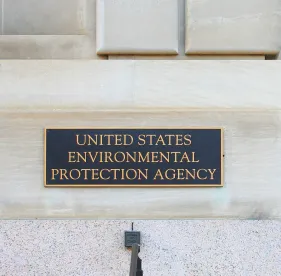One man’s trash is another man’s treasure. In this case, one man’s solid waste, commercial and industrial waste, biomass, plastics, tires, and organic contaminants are another man’s energy, fuel, and commodity chemicals thanks to waste conversion technologies generally known as pyrolysis and gasification. For years, these waste conversion technologies have been regulated under a patchwork of ill-fitting Clean Air Act (CAA) regulations and remain at relatively low levels of commercial adoption. Now that may be changing.
On September 8, the US EPA announced an advanced notice of proposed rulemaking (ANPRM) to “assist in the potential development of regulations for pyrolysis and gasification units,” which, many hope, represents the first step in standardizing and clarifying regulations for these technologies. In addition, last August EPA issued a proposed rule for Other Solid Waste Incineration (OSWI) plants which would simplify pyrolysis regulations by removing the reference to pyrolysis from the definition of “municipal waste combustion unit.” In the ANPRM, EPA states that it would issue the final OSWI Rule by October 31.
The processes of pyrolysis and gasification are not defined in current law. These processes have changed and improved over the years and now come in a variety of different configurations such as high- and low-temperature gasification, plasma gasification, thermal or catalytic pyrolysis, and hydrocracking. Broadly speaking, pyrolysis is a non-combustive process which involves decomposing feedstock under heat in low-to-no oxygen environments and produces tars, oils, particulate matter, and reduced sulfur and nitrogen compounds. In gasification, where one of the main differences is the presence of oxygen, feedstock is reacted with steam or oxygen under high-heat (even low-temperature gasification occurs at several hundred degrees Celsius) and produces, among other products, syngas which has a wide variety of applications including use as a fuel.
Pyrolysis and gasification technologies remained underutilized in the United States where few plants exist and fewer still are in regular commercial operation. But industry interest in chemical and plastics recycling is rapidly growing and EPA’s recent steps to standardize regulations may assist in the development and adoption of chemical recycling and waste conversion technologies. Reforming the regulatory landscape will help provide clarity in this emerging area.
One difficulty EPA has had in regulating pyrolysis and gasification is that the exact processes are poor fits for many existing regulatory categories. Pyrolysis has long been regulated (to the extent necessary given its low adoption) under CAA Section 129, 42 U.S.C. § 7429, which requires EPA to establish performance standards (New Source Performance Standards (NSPS) and Emissions Guidelines (EG)) based on Maximum Achievable Control Technologies (MACT) for solid waste incineration units “which combust[] any solid waste material from commercial or industrial establishments or the general public.” EPA promulgates these regulations for new and existing units as well as a general “other categories of solid waste incineration units” or OSWI.
Currently, OSWI regulations provide that a “municipal waste combustion unit” (MWC) includes “pyrolysis/combustion units.” 40 C.F.R. § 60.3078. But the regulations do not define “pyrolysis/combustion” and that term appears only in the definition for municipal waste combustion units and the definition of OSWI only includes “very small municipal waste combustion unit[s]”; even so, EPA has previously taken the position that pyrolysis is also regulated as an OSWI under the definition of “institutional waste incineration unit” notwithstanding the fact that a reference to pyrolysis exists only in the definition of MWC. Needless to say, industry participants have found this a vexing and confusing regulatory regime.
And so the August 2020 Proposed Rule seeks to remove the reference to pyrolysis from the OSWI regulations. EPA is proposing to remove pyrolysis from OSWI definitions because “such [pyrolysis] units are used to combust uncontained gases and do not involve the combustion of solid waste as defined in the OSWI rule.” Indeed, pyrolysis does not involve combustion at all. Rather, pyrolysis decomposes or “cracks” feedstock at high heat, with a catalyst (catalytic cracking) or without (thermal cracking). Contrary to a combustive process, pyrolysis is endothermic—the cracking reaction takes in heat rather than emitting it.
The August 2020 Proposed Rule is the culmination of over fifteen years of litigation and rulemaking stemming from the EPA’s original promulgation of OSWI regulations in 2004. Environmental groups have already indicated they believe the Proposed Rule is not acceptable and further litigation over the rule seems likely. It remains to be seen whether the Rule and the pyrolysis/OSWI amendment take effect as planned.
Meanwhile, the ANPRM takes a broader view but is non-committal about what, if any, concrete steps EPA plans. For the moment, the ANPRM is a purely informational exercise that does not require EPA to take any steps if it does not see fit to do so. It seems more likely than not that EPA intends to use the ANPRM to comprehensively overhaul its pyrolysis regulations following the OSWI Rule’s expected enactment in October, and regulating gasification alongside makes sense given its parallel role in chemicals and waste recycling.
EPA’s action is not just a necessary reform to a long-ambiguous set of regulations—providing greater guidance here will allow regulated industries to more fully embrace emerging mechanisms for addressing two pressing environmental issues: effective destruction of resilient contaminants and recycling carbon-intense plastics and chemicals.
“PFAS,” per- and polyfluoroalkyl substances, are a broad category of chemicals with a wide variety of industrial and commercial uses. While domestic industry partners have voluntarily agreed to wind down usage of certain types of PFAS, a vexing issue remains in how to ensure destruction of PFAS-contaminated substances which are remarkably resilient and long-lasting. EPA’s PFAS Innovative Treatment Team (PITT) published a Research Brief this January discussing the use of pyrolysis and gasification processes in destroying PFAS-contaminated waste. PITT identified pyrolysis and gasification as “promising technologies” in the effective destruction of wastewater solids containing PFAS. Effective destruction of PFAS-containing wastewater would be a significant benefit.
More broadly, modern pyrolysis and gasification technologies hold a great deal of promise in promoting effective plastics and chemical recycling and reducing the need to use new inputs. As EPA recognized in the ANPRM, pyrolysis and gasification do not degrade the quality of the output relative to the feedstock and so have the potential to “generate a ‘circular economy’ around plastics use, where a post-consumer plastic product can be recycled to produce a plastic of equal or similar quality again instead of being disposed of or ‘downcycled’ to lesser quality products.” Effective and wide-spread adoption of pyrolysis and gasification may reduce the demand for virgin inputs in chemicals manufacturing and so reduce related emissions and environmental impacts. As public pressure mounts to reduce or eliminate single-use plastics and increase recycling, clearer regulation of pyrolysis and gasification may assist industry adoption of these technologies.
Comments on the ANPRM are currently due November 8, 2021.




 />i
/>i
